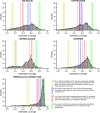Prediction of Antibiotic Susceptibility for Urinary Tract Infection in a Hospital Setting
- PMID: 32312778
- PMCID: PMC7318043
- DOI: 10.1128/AAC.02236-19
Prediction of Antibiotic Susceptibility for Urinary Tract Infection in a Hospital Setting
Abstract
Empiric antibiotic prescribing can be supported by guidelines and/or local antibiograms, but these have limitations. We sought to use data from a comprehensive electronic health record to use statistical learning to develop predictive models for individual antibiotics that incorporate patient- and hospital-specific factors. This paper reports on the development and validation of these models with a large retrospective cohort. This was a retrospective cohort study including hospitalized patients with positive urine cultures in the first 48 h of hospitalization at a 1,500-bed tertiary-care hospital over a 4.5-year period. All first urine cultures with susceptibilities were included. Statistical learning techniques, including penalized logistic regression, were used to create predictive models for cefazolin, ceftriaxone, ciprofloxacin, cefepime, and piperacillin-tazobactam. These were validated on a held-out cohort. The final data set used for analysis included 6,366 patients. Final model covariates included demographics, comorbidity score, recent antibiotic use, recent antimicrobial resistance, and antibiotic allergies. Models had acceptable to good discrimination in the training data set and acceptable performance in the validation data set, with a point estimate for area under the receiver operating characteristic curve (AUC) that ranged from 0.65 for ceftriaxone to 0.69 for cefazolin. All models had excellent calibration. We used electronic health record data to create predictive models to estimate antibiotic susceptibilities for urinary tract infections in hospitalized patients. Our models had acceptable performance in a held-out validation cohort.
Keywords: antibiotic coverage; antibiotic resistance; predictive models; urinary tract infection.
Copyright © 2020 American Society for Microbiology.
Figures


References
Publication types
MeSH terms
Substances
Grants and funding
LinkOut - more resources
Full Text Sources
Medical

